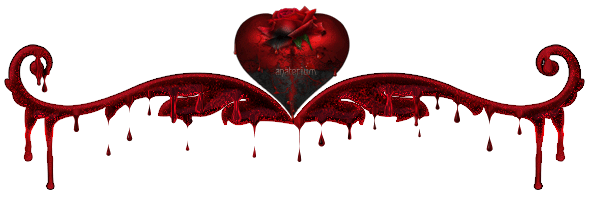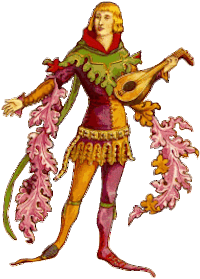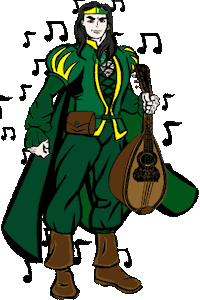
Courtly Love:
Fin' amor

The various modes of love in the troubadour poems and in medieval literature of romance, from the 12th to the 14th century, have been designated by the single term: amour courtois or "courtly love," a term coined in 1883. It has since served most medievalists and literary historians to characterize the variety of concepts and modes of love illustrated in this love literature. However, the term “courtly love” has been criticized as ill-defined and misleading, and thus the proper term for defining the love of the troubadours is fin’amor (refined or sublime love).
So-called “courtly love” developed during the 12th century in the South of France (Occitania) and became an ideal in courtly society, both literary and real, throughout Europe for the rest of the Middle Ages. It celebrated and intensely idealized form of sexual passion — the kind of falling in love with which every society in every age is familiar – in a highly elaborate, sophisticated, and aristocratic code of behavior. This code of love was known by the key concepts “chivalry” and “courtliness” (cortesia). Courtliness was the ethical and social ideal of chivalry, a code of good manners and a guide for a gentleman. In romance literature, cultivation of the refined and ennobling emotions of fin’amor civilized the warrior knight into the courtier and gentle-man.
This sophisticated cult of love, with its emphasis on emotion and suffering, transformed the values of the existing aristocratic literature and medieval society in general. The troubadour art of composing love poetry (gai saber, “joyous science”) transformed common love into a more refined form of love dominated by the imagination. The troubadour concept of fin’amor has permanently influenced our culture and the way we think about "romantic love" in our own time.







_.jpg)
.jpg)
.
Troubadours & Their Beloveds
.

"The Lovers"

"The Lovers"

"Young Love In Spring"





















.
Troubadours & Unrequited Love: Love's Wound
.

.
In the troubadour “Art of Love,” the entire spectrum of love/amor—its joys and sorrows (the rose and the thorns)—was recognized and accepted, and the theme of unrequited love was prevalent in troubadour song.
.
“Love is only known by him who hopelessly persists in love.” ~Friedrich Schiller
.





.

The excesses of the passion of romantic love has been an abnormal phenomenon found in the poetry and song from the Troubadours to the Romantics. This “transgressive love” (love that exceeds the accepted social and moral boundaries), has been conceived as a “madness,” a “fever” or a “sickness” (i.e., “lovesickness”). However, the twelfth-century troubadours, who coined the term of fin' amor (“refined love”), conceived of it as a great paradox of love; you couldn't have the beautiful “rose” (i.e., the beloved, such as “Rosebud”) without its wounding “thorns;” none of love's joys without its sorrows. In this sense, the suffering of an “unrequited love” for an unattainable lady was taken on with great acceptance. Thus, for the troubadours, the reigning god of love, Eros, is the arrow, the disease, and the cure.
The following is from two troubadours:
“He knows little of love who does not await mercy, for love desires us to suffer and to wait; then in a little time love repairs and amends all the pain he has made us endure so long, and that is why I prefer to die having known true love than to live with a high heart empty of love, for so love fated me from the beginning.”
“Blessed be the pains, the sorrows and the cares which I have long suffered cause of love. Because of them I taste a thousand times more intensely the good which love now makes me feel. So much do the ills of the past cause me to enjoy my present happiness that it seems to me that if there were no evil one would hardly be able to savor the good. Thus evil enhances the good and therefore should be welcomed when it comes.”
So we find the same paradoxical ideal in Wolfram's epic romance Parzival. Trevrizent the hermit says to Parzival:
“The spear had to be thrust into the wound; then one pain helped the other, and from this spear became blood-red... What wondrous things this poison can do. From sorrow they received their wages, for the spear which pierced their hearts to the core carried away their joy. Then in the constancy of their grief they were baptized anew.”
Then there's the following from Chreitien De Troyes, the great medieval writer of the Arthurian romances:
“From all other ills doth mine differ. It pleaseth me; I rejoice at it; my ill is what I want and my suffering is my health. So I do not see what I am complaining about; for my ill comes to me by my will; it is my willing that becomes my ill; but I am so pleased to want thus that I suffer agreeably, and have so much joy in my pain that I am sick with delight.”
The same sentiment can be found from a later Baroque poet in this love tradition, Richard Crashaw:
“For in Love’s field was never found / A nobler weapon then a wound. /Love’s passives are his activ’st part, / The wounded is the wounding heart.”
The Romantic poet Novalis carries this troubadour paradox of love into the 18th century and the Pre-Raphaelite poet, Dante Gabriel Rossetti, carries it into the 19th:
“Whoever flees pain / will love no more./ To love is always / to feel the opening / to hold the wound / always open.”
“Beyond the sphere which spreads to widest space / Now soars the sigh that my heart sends above ; / A new perception born of grieving Love / Guideth it upward the untrodden ways.”
The Pulitzer Prize winning American playwright and novelist, Thorton Wilder, carries it into the 20th century:
“Without your wounds where would your power be? It is your melancholy that makes your low voice tremble into the hearts of men and women. The very angels themselves cannot persuade the wretched and blundering children on earth as can one human being broken on the wheels of living. In Love’s service, only wounded soldiers can serve. Physician, draw back.”
Finally, this troubadour paradox of love finds its champion in the 20th century with the modern troubadour, Leonard Cohen, who knows that even though “The doctors working day and night / ... they'll never ever find that cure for love:”
“… The thorn of the night in your bosom / The spear of the age in your side / Lost in the rages of fragrance / Lost in the rags of remorse / Lost in the waves of a sickness / That loosens the high silver nerves … // And leave no word of discomfort / And leave no observer to mourn / But climb on your tears and be silent / Like a rose on its ladder of thorns ….” (“The Window” )

.


.



The paradox of Amor & the Rose:
"The way the night knows itself with the moon,
be that with me. Be the rose
nearest to the thorn that I am."
~ Jelaluddin Rumi
"Misery and joy have the same shape in this world:
You may call the rose an open heart or a broken heart."
~Khwaja Mir Dard (18th century Sufi and Mughal poet)
"Out of the shell of the broken heart emerges the newborn soul."
~ Hazial Inayat Khan, The Heart of Sufism

.jpg)
"Love's Wounds" (Bouguereau)



The Path of True Love Never Did Run Smooth (Hughes)


Why There Ain't No Cure For Love
“The arrow that inflicts the wound is the same as the arrow that heals it.” ~Romantic adage
“This is a very mysterious thing that electric thing that happens and then the agony—that can follow which is that which the troubadours celebrate—the agony of the love, the sickness that doctors can’t cure. The wound can be healed only by the weapon that delivers the wound. What the wound is the wound of my passion and agony of love for this creature and the only one who can heal me is the one who delivered the blow you know.” ~Joseph Campbell
Unrequited Love
_jp.jpg)
Unrequited Love: "Dante and Beatrice" (Waterhouse)

Unrequited Love

Unrequited Love: "Dante's Dream at the Time of the Death of Beatrice" (Rossetti)

Unrequited Love
Just remember, the sweet is never as sweet without the sour, and I know the sour. . .
You can do whatever you want with your life, but one day you'll know what love truly is. It's the sour and the sweet. And I know sour, which allows me to appreciate the sweet.
~ Brian, Vanilla Sky (2001. Cameron Crowe)

The Troubadours
Famous Troubadours
.

.jpg)
"The Troubadour" (Moitiroux)



"The Troubadour"

"Troubadour Varo"
.jpg)
"The Troubadour" (Brunery)
.jpg)
.jpg)
"The Trubadour" (von Zichy)
"The Troubadour" (Franquelin)

.jpg)
"The Troubadour" (Vinea)

.
Trobairitz
.
The trobairitz were Occitan female troubadours of the 12th and 13th centuries, active from around 1170 to approximately 1260. The word trobairitz was first used in the 13th-century romance Flamenca. Trobairitz composed, wrote verses, and performed for the Occitan noble courts. They are exceptional in musical history as the first known female composers of Western secular music; all earlier known female composers wrote sacred music. Although troubadours sometimes came from humble origins, the trobairitz were nobly born. The most important trobairitz are Comtessa de Diá, Castelloza, Alamanda de Castelnau, Azalais de Porcairagues, Maria de Ventadorn, Tibors, Comtessa Garsenda de Proença, Gormonda de Monpeslier, Gaudairença and Beatritz de Romans.
.
















.jpg)
"The Gentle Music of a Bygone Day" (Strudwick)



Marie de France, Lais of Marie de France
"The Gentle Music of a Bygone Day" (Hall)
.jpg)
"Songs Were Sweet" (Strudwick)
.jpg)
"The Old Days" (Strudwick)
.
Troubadours, Trobairitz, & Trouvères Performing
.





















.

.
Christian & Muslim Troubabours Performing "Catinas de Santa Maria" at Court of Alfonso X
.






.
Troubadours & Trobairitz Songbooks & Chansonsheets
.

"Troubadour Early Music"
.jpg)
"Lovers" (Guillaume de Machaut)






















.
The Jongleurs were often collaborators or assistants of medieval troubadours or minstrels, who performed the songs of the latter. Jongleurs gained a reputation of itinerant entertainers. Their repertoire included extravagant skills in dancing, conjuring, acrobatics, and juggling. The Jongleurs also played a part in singing, and storytelling.
.

The main topic of troubadour poetry is love, and it was the need to express works as succinctly as possible that led to the establishment of genres, distinguished less by form than by content or situation. Some of the most common genres of troubadour poetry were:
-
cansos (courtly love-songs, consisting of five or six stanzas with an envoi - a short stanza at the end used either to address an imagined or actual person or to comment on the body of the poem)
-
comiat (a song renouncing a lover)
-
serena (the song of a lover waiting impatiently for the evening to consummate his love)
-
maldit (a song complaining about a lady's behaviour and character)
-
escondig (a lover's apology)
-
albas (morning songs, generally about having to separate after a night together: typically lovers are warned by a watchman that morning is approaching and that they both risk discovery by the jealous husband)
-
sirventes (satirical political poems)
-
planhs (laments,especially on the death of some important figure)
-
pastorela (amorous encounters between a knight and a shepherdess)
-
crusade song (canso de crozada – a song about the crusades, usually encouraging them)
-
dansa or balada (dance songs with a refrain, mock-popular songs based on an established dance form)
-
descorts (literary jokes discordant in verse form or feeling)
-
tensos (songs of debate)
-
trobars clus (cryptic poems)
-
sestina (highly structured verse form)
-
razos (prose explanations accompanying poems, often added at the end)

The Nature Introductions of Troubadour Poetry
The troubadours often used a nature introduction to a poem called an “exordium,” where springtime weather inspires and bird songs “teach” the poet to sing. A later variation of this was where dark weather inspired dark thoughts; cackling or shrieking birds reflect a traitor’s counsel in contrast to the poet’s own harmonious advice. The bird in many troubadour cansos serves as the poet’s “messenger,” who will carry his message to his beloved. (The figure of the bird in troubadour poetry is plentiful enough to be considered a standard trope or motif—today considered a poetic cliché. Actually, the song-bird is archetypal, in that it goes back to the origins of love poetry and is a symbol for both the love song and its mythopoetic tradition.)
There is another nature introduction, called a reverdie or “greening,” which specifies time of composition at the end of March. Spring inspires love and song, and the poem’s position is love plea.
For samples of these exordiums and reverdies in troubadour poetry, click link below.
The Alba of Troubadour Poetry
.
The alba, or “dawn song,” is a complaint of two lovers who have been warned by a night watchman that day approaches and that they must now separate, for the jealous husband may at any time surprise them. Each stanza ends with a refrain, and this refrain ends with the word alba (dawn).
The relatively rare genre of the alba “dawn song,” though not appearing in troubadour poetry proper until Guiraut de Bornelh’s “Reis glorios,” may have existed in Provençal even before the “first troubadour,” William IX of Aquitaine (early twelfth century). Evidence for its existence is to be found in the “bilingual alba,” a late-tenth-century Latin poem with a two-line refrain in early Romance language (which may or not be Occitan) that is only partly decipherable. The genre of dawn song depicts a dramatic situation involving three people: an adulterous couple spending the night together, the man’s friend who serves as watchman to warn them when the sun rises, and the jealous husband likely to arrive on the scene. It is thought that this situation is actually a bit marginal for troubadour poetry, since the dawn song finds the lovers not in the state of perpetual desire that characterizes the genre of the canso (love song), but rather a moment of fulfilled desire and contentment.
A related term is the aubade, a morning love song (as opposed to a serenade, intended for performance in the evening), or a song or poem about lovers separating at dawn. It has also been defined as “a song or instrumental composition concerning, accompanying, or evoking daybreak.” In the strictest sense of the term, an aubade is a song sung by a departing lover to a sleeping woman. The tradition of aubades goes back at least to the troubadours of the Provençal schools of courtly love in the High Middle Ages. Aubades are generally conflated with what are strictly called albas, which are exemplified by a dialogue between parting lovers, a refrain with the word alba, and a watchman warning the lovers of the approaching dawn.
For some samples of the alba, click the link below.

The music manuscript above is troubadour Guiraut de Bornelh's famous alba, "Reis Glorios." Below is a modern rendition of it.
.
.
Boethius, The Consolation of Philosophy & Music
.
.jpg)
.jpg)
Italian manuscript (1385 CE) of The Consolation of Philosophy (524 CE): Miniatures of Boethius teaching and in prison.
.
"Let us bring to bear the persuasive powers of sweet-tongued Rhetoric and . . . let us have as well Music, the maid-servant of my house, to sing us melodies of varying mood." (Boethius, The Consolation of Philosophy)
Boethius--a philosopher after my own heart--wasn't satisfied in publishing a book of (Neoplatonic) philosophy without musical accompaniment. (As the GS defines his musical essay: "Argument & Song.")
Reconstruction of the Lost Songs from The Consolation of Philosophy
"Hundreds of Latin songs were recorded in neumes from the ninth century through to the thirteenth century, including settings of the poetic passages from Boethius's The Consolation of Philosophy. The music of this song repertory had long been considered irretrievably lost because the notational signs indicated only melodic outlines, relying on now-lapsed oral traditions to fill in the missing details."
Apparently, The Consolation of Philosophy not only influenced the philosophy of the medieval period but, most importantly, it influenced the poets of Occitania, especially the troubadours.
"There is an 11th-century fragment in Provencal of two hundred and fifty-seven decasyllabic verses preserved in an Orléans manuscript. It is believed to have come from Limousin in the north of the Occitan region. The unknown author takes Boethius's treatise, De consolatione philosophiae. as the groundwork of his composition."
.
Troubadour Court of Love (Cour Amoreuse)
.

Eleanor of Aquitaine's Court of Love

Marie de Champagne's Court of Love
.jpg)






.jpg)


.
Troubadour Garden of Love
.












.
Troubadour Book of Love
.


.

"The book of love has music in it
In fact that's where music comes from"
-Peter Gabriel, 'The Book of Love'
.


.
Troubadour Art of Courtly Love & Chivalry
.



.jpg)
.


.
The Albigensian Crusade Against the Heretics
.





For blog essay "The Heretics of the Provence & the Albigensian Crusade ," click on button
.
Geography & Language of the Troubadours
.
The Gypsy Scholar will be using two terms interchangeably that geographically identify the region of what we know today as southern France: Occitania (or the Occitan) and Languedoc. This can be confusing, but both are the standard usage among scholars and other writers dealing with the 12th-century Troubadours. (The "Troubadours of the Provence" has become the popular and common designation, even though in the 12th century the region of the Provence was only one among several provinces and not the original home and place of activity of many troubadours. Hence the entire cultural-linguistic designation for the troubadours: Provençal.) The term Languedoc can also be confusing, since it is both a geographical and linguistic (langue d'oc) designation. As a geographical region of the Middle Ages, Languedoc represented a greater area than the province of the same name today (as did the Provence itself). When scholars use the designation Languedoc for Southern of France, wherein dwelt the troubadours, they are referring to the entire region where a Latin-based Romance language was spoken (langue d'oc), as distinct from the Northern France (langue d'oïl). For a more detailed explanation of all this, click link below.
.













.
12th century Carcassonne fortress. Carcassonne, inhabited since the Neolithic period, is located in the south of France about 80 kilometers east of Toulouse in the region of Occitanie on the plain of the river Aude between historic trade routes, linking the Atlantic to the Mediterranean Sea and the Massif Central to the Pyrénées. Its citadel, known as the Cité de Carcassonne, is a medieval fortress dating back to the Gallo-Roman period. It was added to the UNESCO list of World Heritage Sites in 1997.
.

.
.
.
Troubadours of the Sixties
.

.
The legacy of the twelfth-century troubadour phenomenon was the eventual rebirth of eros in the nineteen-sixties; a powerful resurgence up from below to have its day in the countercultural music of the Sixties. There are enduring parallels between the original troubadour Twelfth-century Renaissance and the cultural rebirth that occurred in the nineteen-sixties.
That special class of singer-songwriters of the Sixties were modern troubadours, because of a subterranean continuity (stylistically and thematically) of a countercultural music tradition. These thematic connections with Sixties folk and folk-rock music are evidence of a profound cultural legacy and inheritance. This is why the label of “troubadour” given to Sixties singer-songwriters (e.g., Willie Nelson, Townes Van Zandt, Gordon Lightfoot, Phil Oaks, Tom Paxton, Tim Buckley, Richard Farina, Joan Baez, Bob Dylan, Arlo Guthrie, Donovan, Paul Simon, Judy Collins, Joni Mitchell, Van Morrison, Leonard Cohen, Jim Morrison, Neil Young, and Cat Stevens) was not a just a willy-nilly designation; it was rather a recognition, however dim, of a special class of poet-musicians that had always emerged to voice the soul of the people—their dreams and visions, their longings and hopes, their anguishes and their joys—, bringing renewal to Western culture.
.




.
Nietzsche's view of the folk-song tradition as an elemental phenomenon and the perfect union of "Apollonian" and "Dionysian" artistic principles seems to anticipate the "60s Folk Revival".
Folk music reached its zenith in the Sixties. This became known as the "American Folk-Music Revival." Contemporary folk music is of a type that includes fusion genres such as folk rock, folk metal, electric folk, and others. Folk rock came onto the scene as a popular genre in the mid-sixties and much of it grew out of the protest movements against the Vietnam War. Lyrically, a lot of folk rock music contained protest messages. Bob Dylan became one of the most prominent song writers of the decade with many popular groups, such as Peter Paul and Mary and The Byrds, successfully covering his songs. However, it was Joan Baez, already a famous folk-singer, who gave Dylan his start, and who became his constant musical partner.
.







.


















